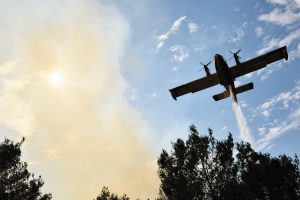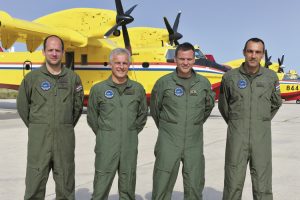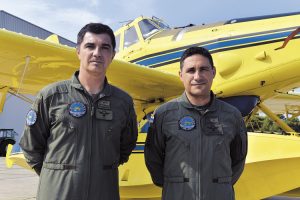The Helicopter Squadron of the 93 rd Air Base at Zemunik on 5 December 2017…
Firefighter Squadron hands-on training
 In summer 2018 Croatia was fortunately spared from large fires, but firemen and members of the Firefighting Forces were busy putting out some 40 fires, logging ca 230 flying hours and dropping ca 5,600 tons of water (figures by 20 August) . They are top-trained pilots of the Croatian Air Force’s Firefighter Squadron,some of whom use the firefighter season to train to become captains or co-pilots on the Firefighter Squadron aircraft.
In summer 2018 Croatia was fortunately spared from large fires, but firemen and members of the Firefighting Forces were busy putting out some 40 fires, logging ca 230 flying hours and dropping ca 5,600 tons of water (figures by 20 August) . They are top-trained pilots of the Croatian Air Force’s Firefighter Squadron,some of whom use the firefighter season to train to become captains or co-pilots on the Firefighter Squadron aircraft.
Canadair Captain Training – focus on decision making
Captain Igor Mindoljević is one of them. He joined the Firefighter Squadron in 2012.,In 2013 he graduated from the Canadair CL-415 co-pilot training and has since late 2017 trained to become Canadair captain, under the supervision of the mentor – Major Tomislav Slavica. To be eligible for the training the candidate has to have two to four years of experience as co-pilots, and perform min. 350 flying hours. Major Slavica stresses that the candidates normally take the training with 500 to 700 flying hours experience.
The training comprises three modules – the first one previews familiarisation and adaptation to the left side of the cockpit. Most trainees acquire the skill fast and then take the flying practice – skimming the water surface: The third module combines all the learned skills and the trainees take part in firefighting operating the canadairs from the left – the captain’s – side over water surfaces. The training plan previews the first two modules administered before the summer season.
“It is most reasonable to schedule the training in autumn, with the first two modules completed by late spring so that the last module kicks off in the fire season.“, says Major Slavica. The training plan previews the trainees put out minor fires during the last module, and are gradually dispatched to extinguish larger ones. However, the gradual approach is only feasible in theory. “In a real situation a trainee may be dispatched to extinguish large fire first, and a small one later“. To assess their fitness for the captain duty the candidates are continuously supervised and after the training take a flight exam.
The main skills taught during the training – flying the Canadair, firefighting management and firefighting tactics. Given the candidates’ rich flying experience, the focus is placed on the latter two.
 Captain Mindoljević appreciates practicing decision making under pressure the most: “I learn to make decisions related to firefighting, to communicate with the firefighters on the ground, to access the fire and to efficiently put it out“. This summer he logged 20 flying hours given the low incidence of fires, but approves of the training: “I am satisfied although I always strive for better. What is important is to correct and to minimise faults to maintain safety in flight“.
Captain Mindoljević appreciates practicing decision making under pressure the most: “I learn to make decisions related to firefighting, to communicate with the firefighters on the ground, to access the fire and to efficiently put it out“. This summer he logged 20 flying hours given the low incidence of fires, but approves of the training: “I am satisfied although I always strive for better. What is important is to correct and to minimise faults to maintain safety in flight“.
Co-pilot in Canadair– a valued analyst and assistant
Although captains have the command responsibility, co-pilots are indispensable on the aircraft as well, as they help captains by analysing the situation at the fire site and suggesting solutions to mitigate it.
Major Milan Došen of the Firefighter Squadron demonstrated the co-pilot training for the “Hrvatski vojnik“ magazine. Maj. Došen has been a member of the Squadron since 2012 and has logged 3,000 flying hours; he was a flight instructor and a test pilot on Air Tractor AT-802 – Fire Boss), and in 2016 took the Canadair co-pilot training which he resumed this year, under the supervision of Lt. Col. Goran Vlahović. The Canadair CL-415 co-pilot training previews familiarisation with the aircraft before and engagement in actions during the firefighting season. Although the second module might seem more demanding ,Major Došen says he invested more effort during the first one. “The firefighting procedure is the same on each aircraft, so I focussed on familiarising with the aircraft. I have flown a single-seat and am now adapting to a two-seat. With a smaller incidence of fires the pilots also train less – 20 flying hours in months – but take every opportunity to make progress. Lt. Col. Vlahović says: “We conduct post-flight briefings, analysing the situation at the fire sites and flight details, which helps prevent the repetition of faults“. Major Došen is planning to take the Canadair captain training as the next step in his career.
Fire Boss captain training
“The instructors insist on dealing with every fire with the trainees, who are therefore busier than the rest of the personnel”, says Major Kos. Each engagement is followed by a post-flight briefing. Captain Smajo says he always strives to perform better. “I would be glad to stay on the job until retirement because it is about helping people and doing something useful for the community“.
 We later watched the training on Air Tractor and talked to Captain Denis Smajo, who had taken part in firefighting with Air Tractor AT-802 F for ten years and is currently in training for captain of Fire Boss which comprises three modules; the first one is also known as conversion training, during which the candidate familiarises with the aircraft. In the second module the trainees acquire three essential skills for Fire Boss: skimming the water surface, water scooping and dropping against the target. His mentor is Major Danijel Kos. Although well-experienced on both Air Tractor types, Capt. Smajo still had to make efforts to master scooping and dropping water bombs from Fire Boss. “The captain training is an interesting novelty for me and it motivates me. The aircraft is much more dynamic and I still have to learn many new elements. “The first two modules are administered prior to the firefighting season, so that the third one – firefighting – is conducted in summer. Nominally, each candidate is expected to log 30 flying hours during the training, but, as Major Kos explains, the duration and the number of the flying hours depend on the progress made by the trainees or on the instructors’ assessment.. Even when the incidence of the fires is low, the instructors on Fire Boss make efforts to engage the future captains extensively. His colleagues share the opinion. “We feel so good after extingushing a fire, for doing such a useful thing“„ says Major Došen.
We later watched the training on Air Tractor and talked to Captain Denis Smajo, who had taken part in firefighting with Air Tractor AT-802 F for ten years and is currently in training for captain of Fire Boss which comprises three modules; the first one is also known as conversion training, during which the candidate familiarises with the aircraft. In the second module the trainees acquire three essential skills for Fire Boss: skimming the water surface, water scooping and dropping against the target. His mentor is Major Danijel Kos. Although well-experienced on both Air Tractor types, Capt. Smajo still had to make efforts to master scooping and dropping water bombs from Fire Boss. “The captain training is an interesting novelty for me and it motivates me. The aircraft is much more dynamic and I still have to learn many new elements. “The first two modules are administered prior to the firefighting season, so that the third one – firefighting – is conducted in summer. Nominally, each candidate is expected to log 30 flying hours during the training, but, as Major Kos explains, the duration and the number of the flying hours depend on the progress made by the trainees or on the instructors’ assessment.. Even when the incidence of the fires is low, the instructors on Fire Boss make efforts to engage the future captains extensively. His colleagues share the opinion. “We feel so good after extingushing a fire, for doing such a useful thing“„ says Major Došen.
